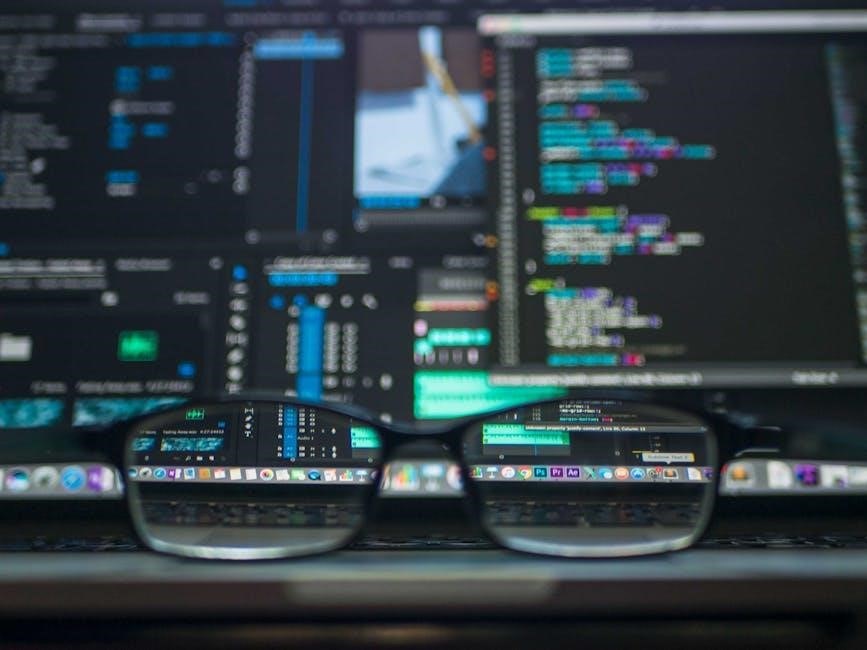Computer forensics involves analyzing digital evidence to uncover facts in criminal or civil cases. This field combines technical skills with investigative techniques to ensure evidence integrity and admissibility in court, making it a cornerstone of modern legal proceedings.
Overview of Digital Forensics
Digital forensics is the systematic process of recovering, analyzing, and presenting data from digital devices to investigate cybercrimes or data breaches. It involves identifying, preserving, and examining evidence while maintaining its integrity. This field applies to criminal and civil investigations, ensuring legal standards are met. Key activities include data recovery, forensic analysis, and presenting findings in court. It is essential for uncovering digital truths in modern investigations.
The Importance of Computer Forensics in Modern Investigations
Computer forensics is crucial in modern investigations as it provides critical evidence in criminal and civil cases. By analyzing digital data, investigators can uncover hidden facts, track cybercrimes, and verify the authenticity of electronic records. This discipline ensures data integrity, aiding legal processes and maintaining justice. Its role is pivotal in combating cyber threats and resolving digital disputes effectively in today’s technology-driven world.

Key Concepts in Computer Forensics
Key concepts in computer forensics include data acquisition, evidence integrity, and legal standards. These principles ensure reliable digital evidence collection and analysis for investigations.
The Digital Forensic Process
The digital forensic process involves identifying, collecting, analyzing, and presenting digital evidence. It starts with securing devices to prevent data tampering. Forensic tools are used to extract data, which is then analyzed for relevant information. The process ensures evidence integrity and admissibility in legal proceedings, following strict protocols to maintain chain of custody and accuracy.
Types of Digital Evidence and Data Acquisition
Digital evidence includes files, emails, logs, and system data stored on devices like computers, phones, and servers. Data acquisition involves creating bit-for-bit copies of storage media to preserve evidence. Techniques like forensic imaging ensure data integrity, while tools like write blockers prevent accidental data alteration, crucial for maintaining evidence reliability in investigations and legal proceedings.
Ensuring Evidence Integrity and Admissibility in Court
Ensuring evidence integrity involves maintaining the authenticity and reliability of digital evidence through secure handling and storage. Legal standards require documentation of every step, from acquisition to analysis, to confirm the evidence’s unaltered state. Admissibility in court depends on strict compliance with these standards, ensuring the evidence is trustworthy and legally acceptable for criminal or civil proceedings.
Tools and Techniques for Digital Investigations
Digital investigations rely on specialized forensic tools and techniques to analyze evidence. Forensic software and hardware enable experts to recover and examine data from various devices securely.
Forensic Software and Hardware Tools
Forensic investigations utilize specialized software and hardware tools to analyze digital evidence. Tools like EnCase, FTK, and Autopsy enable experts to recover deleted files, analyze disk images, and extract metadata. Hardware tools, such as write blockers and forensic imagers, ensure data integrity during acquisition. These tools are essential for conducting thorough and legally admissible digital forensic examinations in criminal and civil investigations.
Methods for Analyzing Windows, macOS, and Linux Systems
Digital forensic experts use OS-specific methods to analyze systems. Windows analysis often involves registry examination and event log review. macOS investigations focus on HFS+ and APFS file systems, while Linux systems leverage command-line tools for file recovery and log analysis. Each OS requires tailored approaches to ensure comprehensive evidence collection and maintain legal standards, reflecting the diversity of digital environments in modern investigations.
The Investigation Process
The investigation process involves setting up a forensic lab, processing crime scenes, and conducting incident response to ensure evidence integrity and legal admissibility in digital forensic investigations properly.
Setting Up a Forensic Lab and Workplace
Setting up a forensic lab requires specialized tools, controlled environments, and proper organization. Essential hardware includes forensic workstations, write blockers, and imaging devices. Anti-static measures and secure storage for evidence are crucial. The workplace should be organized into zones for intake, analysis, and storage to maintain efficiency and integrity. Proper documentation and standardized protocols ensure consistency and legal compliance in digital forensic operations.
Processing Crime Scenes and Incident Response
Processing crime scenes involves securing digital evidence, documenting the environment, and collecting devices. Forensic experts follow strict protocols to prevent contamination. Incident response requires rapid assessment to preserve data integrity. Specialized tools are used to extract evidence while maintaining chain of custody. Proper handling ensures digital evidence remains admissible in court, crucial for investigations and legal proceedings.
Legal and Ethical Considerations
Legal and ethical standards ensure digital evidence is collected and analyzed lawfully. Adhering to guidelines like ACPO protects privacy and maintains evidence integrity for court admissibility.
Understanding Legal Standards for Digital Evidence
Legal standards for digital evidence ensure its admissibility in court by verifying authenticity and integrity. Guidelines like ACPO emphasize proper collection, storage, and documentation processes to maintain chain of custody. Non-compliance can result in evidence being deemed inadmissible, undermining investigative outcomes. Understanding these standards is crucial for forensic professionals to uphold legal requirements and ethical practices in digital investigations.
Adhering to ACPO and International Guidelines
Adhering to ACPO and international guidelines ensures digital evidence is handled with integrity, maintaining its admissibility in court. These standards emphasize proper documentation, chain of custody, and secure storage to prevent tampering. Compliance is critical for forensic professionals to uphold legal and ethical standards, ensuring reliable and defensible outcomes in investigations.
Specialized Investigations
Specialized investigations focus on Mac forensics, email abuse, and server log analysis, requiring tailored tools and expertise to uncover digital evidence effectively and maintain legal standards.
Mac Computer Forensics and Specialized Tools
Mac computer forensics requires specialized tools to handle unique file systems like HFS+ and APFS. Tools like Blackbag Technologies enable experts to recover deleted data, analyze metadata, and decrypt encrypted files. These tools are essential for conducting thorough investigations on Apple devices, ensuring evidence integrity and compliance with legal standards for digital forensics.
Email Abuse Investigations and Server Log Analysis
Email abuse investigations involve analyzing message headers and server logs to trace origins and identify perpetrators. Tools like EnCase and FTK help extract metadata, while server logs provide timestamps and IP addresses. This process ensures evidence integrity, crucial for court admissibility, and helps combat cybercrimes like phishing and spamming effectively.

Advanced Topics in Digital Forensics
Advanced topics include cloud forensics, AI-driven analysis, and automation, enhancing efficiency in handling complex datasets and modern investigative challenges.
Cloud Forensics and Data Recovery
Cloud forensics involves investigating cloud-based data to recover and analyze evidence. It addresses unique challenges like jurisdictional issues and data dispersion across servers. Specialized tools and methods are used to ensure data integrity and recover evidence from cloud environments without compromising legal standards, making it crucial for modern digital investigations.
Incident Response and Cybercrime Investigations
Incident response involves reacting to security breaches to minimize damage and restore systems. Cybercrime investigations focus on tracing and prosecuting digital offenses. Both require forensic expertise to collect and analyze evidence, ensuring legal standards are met. These processes are critical in addressing modern cyber threats, from data breaches to malware attacks, providing a structured approach to mitigating risks and ensuring justice.

Training and Professional Development
Education and certifications in digital forensics are essential for professionals, offering hands-on training and real-world applications to master investigative techniques and stay updated with emerging technologies.
Education and Certification in Digital Forensics
Education and certification in digital forensics are crucial for professionals, offering comprehensive training in investigative techniques and tools. Programs like bachelor’s degrees in cybersecurity and specialized certificates provide hands-on experience. Instructors with real-world expertise guide students through practical scenarios, ensuring they master evidence handling and legal standards. These programs equip learners with the skills to excel in digital forensics and adapt to emerging technologies.
Real-World Applications and Expert Insights
The guide emphasizes real-world applications, bridging theory and practice through expert insights. Seasoned professionals share practical experiences in incident response, data recovery, and email abuse investigations. These real-world scenarios provide learners with actionable knowledge, preparing them for diverse challenges in digital forensics. Expert contributions ensure the content remains relevant and aligned with industry standards, offering invaluable perspectives for both novices and experienced investigators.

Future Trends in Computer Forensics
Emerging technologies like AI and automation are revolutionizing digital investigations, enabling faster evidence analysis. Cloud forensics and advanced data recovery techniques are also becoming critical in modern investigations.
Emerging Technologies and Challenges in Digital Investigations
Emerging technologies like AI and automation are transforming digital investigations, enabling faster and more accurate evidence analysis. Cloud forensics and advanced data recovery tools address evolving challenges. However, encryption, data privacy laws, and cross-border evidence requests complicate investigations. Staying ahead of cybercriminals requires continuous updates in tools and methodologies to handle growing data volumes and complex digital landscapes effectively.
The Role of AI and Automation in Forensic Analysis
AI and automation are revolutionizing forensic analysis by enhancing speed and accuracy in processing digital evidence. Automated tools can analyze vast datasets, identify patterns, and flag critical evidence, reducing manual effort. AI-driven algorithms improve incident response and threat detection. However, reliance on these technologies requires careful validation to ensure accuracy and compliance with legal standards, balancing efficiency with reliability in investigations.




About the author